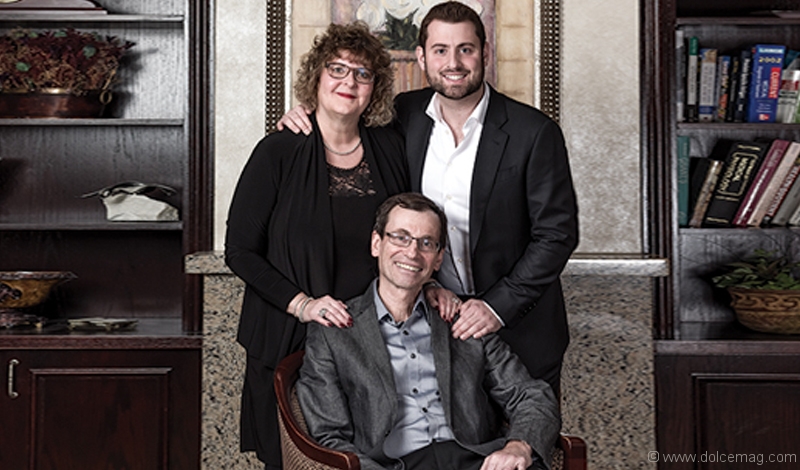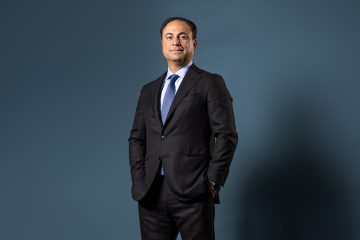Yaron Panov – Hope in the Smallest Places
A family’s fight against an aggressive disease and their battle to bring a potentially game-changing technology in cancer treatment to Canada.
Update: After courageously battling sarcoma cancer for seven years, it is with great sadness that we share the passing of Lucian Yaron Panov on July 5, 2017. The Dolce family extends their deepest condolences to Rochelle, Elan, Adi and family. Lucian’s legacy lives on through “The Panov Program in Precision Chemotherapy & The Panov Research Fund” at Mt. Sinai Hospital.
Yaron Panov’s cancer returned. In the spring of 2011 the then 55-year-old husband and father of two had been diagnosed with liposarcoma, a rare and aggressive cancer, and underwent surgery to have it removed from his abdomen. But roughly four months after the procedure, the cancer grew back. He was given four to six months to live.
“Suddenly they tell you it’s cancer and there’s no cure, and you don’t know what to do. You’re completely lost,” Panov recalls. “I was scared. It was: this is it. I’m going to die, I have to organize my things, and this is it.’”
It’s a cold reality faced by many Canadians diagnosed with a life-threatening disease. In a medical system with only so much money to spend on so many sick, patients can become numbers and doctors must make hard choices as to which cases they believe they can treat successfully. A long-shot case such as Panov’s wasn’t one of them. It was devastating news. But it was a fate Panov’s physician-wife Dr. Rochelle Schwartz simply wouldn’t accept. “I’m not the type that takes no for an answer,” she says.
Despite the heavy weight of her husband’s death sentence she soldiered on, looking for answers. Her sister had told her about a friend in Baltimore who was diagnosed with lung cancer; he too was given only six months to live. But the man began working with Dr. David Sidransky, a leading oncologist at Johns Hopkins Medicine and founder of technology company Champions Oncology. He was able to find a new lease on life through an innovative approach to cancer treatment that utilized avatar mice technology.
Avatar mice technology takes cancerous tissue from patients, often during biopsy or surgery, and implants it in mice. By taking part of the tumour and the surrounding “neighbourhood” — blood vessels, fat cells, nerve cells, etc. — they’re able to grow a replica of the patient’s cancer in the mice. They then test various chemotherapies or cocktails of them on the cancer in the mice to determine which is most effective against the cancer.
“Instead of trying it on the person you start to try it on the mice,” says Dr. Schwartz. These tiny beacons of hope eliminate much of the hit-or-missing of chemotherapy, boosting the treatment effectiveness from a disheartening 10 to 30 per cent to an encouraging 94 per cent. It also means patients don’t have to suffer the debilitating side effects of chemotherapy — the pain, the nausea, the uncertainty — for nothing.
This treatment, which Dr. Schwartz notes has been used in the U.S. and Israel for roughly nine years, however, isn’t available in Canada. Dr. Schwartz contacted Dr. Sidransky to see what the options were for her husband. After a teleconference was arranged with top sarcoma specialists, they determined it wasn’t chemo Panov needed, but a good surgeon. It came with a hefty price tag, but it would mean Panov’s life. They flew down a few days later for the surgery.
When they returned from the U.S. they were rocked with more bleak news: they were “blacklisted.” “When we came back from the States, no doctor in Ontario would see my husband,” says Dr. Schwartz. “We were very upset. We were very disappointed. We were very angry.”
They were forced to travel back down to the U.S. for three more surgeries, which cost $75,000 each. With the bills racking up and no help from OHIP, they resorted to selling their home to cover the $350,000 they would eventually spend on the surgeries and the avatar mice treatments. But despite the mounting expenses, they were making headway. The mice avatars revealed a new chemo, an MDM2 inhibitor, that was working. The problem was getting it, and the mice avatar technology, here.
“I just decided we can either be angry and upset or we can use our energy and turn it around and do a family project of bringing this technology to Canada,” says Dr. Schwartz.
They began working with Mount Sinai Hospital and were told if they could raise the $1 million needed for a five-year research study the hospital would take it on. They endeavoured tirelessly to find the funding, including through two galas organized by their son Adam, which raised $57,000 and $222,000 respectively in proceeds. With the money eventually in place, they established the Panov Program in Precision Chemotherapy for Sarcoma Research at Mount Sinai, welcoming their first patient into the study this past November. Former Toronto mayor Rob Ford was also part of the study, but unfortunately time was not on his side when he succumbed to his cancer on March 22.
The Panov Program’s goal is to find customized chemotherapy treatments for patients with life-threatening sarcomas. Panov, now 61, has been undergoing treatment at Mount Sinai for the past three months and they’re seeing positive results thanks to the greater precision granted by the avatar mice. “It’s liquefying the tumours,” says Dr. Schwartz. Even with the whole sarcoma community monitoring his case, Panov is feeling upbeat. Undergoing chemo is already a taxing experience, even without the uncertainty of its effectiveness. Knowing that all that pain and nausea will be worth it eliminates pressure and negativity. “What is positive with this whole story is that I didn’t have to go through the experience of getting this chemo just to be told, ‘Sorry, it doesn’t work,’” he explains.
While he’ll be on chemo periodically for the rest of his life to keep the cancer in check, the precision from the avatar mice technology has given Panov that one thing no money can buy: time. Time to allow for new, more effective treatments to develop, but most of all: time for new experiences with family and friends.
“This is the first technology that actually helps patients today, now,” Panov says. “It’s not some kind of research that in five, ten years maybe it will work. It’s today. And that’s why I wanted to bring it to other patients in Canada, so other people can enjoy that luxury of not testing the chemo on you but testing it on the mice.”
The family believes their story is a testament to the power of second opinions. “If I was afraid of offending the doctors he would be dead,” Dr. Schwartz says. But she doesn’t want patients to disregard a doctor’s suggestion. It takes roughly three months to grow the cancer in the mice and test the various chemos. For those with aggressive cancers, that’s time they can’t afford. As such, the mice avatars should be grown in parallel. “This is in conjunction. It’s not instead of,” she adds. “If your doctor’s treatment works on you, great, then you’re going to continue that treatment. But if it doesn’t work then we start having some other options.”
With the Panov Program being so successful, the family has decided to launch a second stage. This new phase will raise another $1 million in a collaborative effort to help sarcoma doctors at Mount Sinai, the Ontario Cancer Institute and hospitals in Israel hunt down the genetic switch that turns benign cells into cancer cells. But the family is also starting to look at their personal future, even if it’s in the smallest things. When sons Adam and Elan were younger, Panov and Dr. Schwartz used to take the family to Disney World every year. “So for my 60th birthday they said, ‘Mom, we’re taking you back to Disney World,’” Dr. Schwartz explains with a warm smile. “I said, ‘Great, we have something so good to look forward to.’”
Sometimes in life that’s the best gift of all.
Photography By Farzam Hosseindoust














































































No Comment